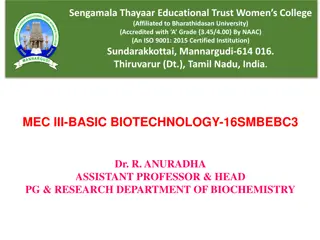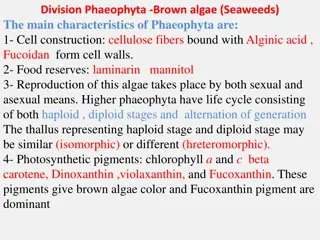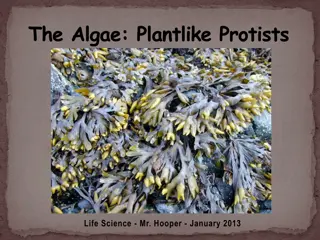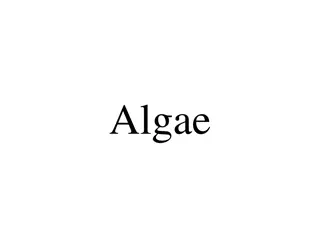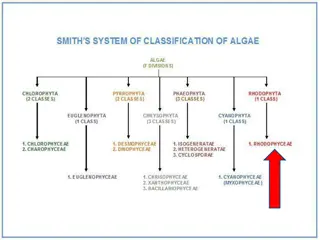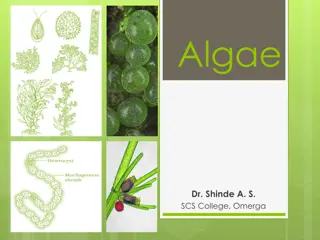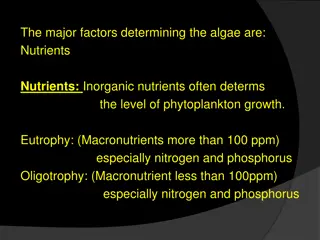Algae Diversity: Habitats and Classification
Algae exhibit remarkable diversity in habitats, including halophytic algae in salt lakes, symbiotic algae with various organisms, cryophytic algae on ice, thermophytes in hot springs, and more. They are classified into different groups based on pigmentation, storage products, and cellular organization. The taxonomy of algae is constantly evolving due to new genetic and ultrastructural evidence, making a definitive classification system challenging.
Download Presentation

Please find below an Image/Link to download the presentation.
The content on the website is provided AS IS for your information and personal use only. It may not be sold, licensed, or shared on other websites without obtaining consent from the author. Download presentation by click this link. If you encounter any issues during the download, it is possible that the publisher has removed the file from their server.
E N D
Presentation Transcript
3. Algae of remarkable habitats In addition to above mentioned some algae also occur in uncommon habitat and termed as: a) Halophytic algae. They grow in the highly concentrated salt lakes. b) Symbiotic algae. They grow in association with fungi, bryophytes, gymnosperms or angiosperms. c) Cryophytic algae. This group of algae growing on ice or snow provide attractive colours to snow-covered mountains.
d) Thermophytes or Thermal algae: This group of algae occurs in hot water springs (50- 70 C). e) Epizoic algae: The algae growing on animals like fish, snail (etc.) are called as epizoic. Endozoic algae: They grow in the tissues of animals. f) g) Parasitic algae: Some algae grow parasitically on different plants and animals.
In 1754 Carl von Linnaeus divided the plant kingdom into 25 classes, of which one, the Cryptogamia. Linnaeus referred four groups to the Cryptogamia, namely the Algae, Fungi, Musci and Filices. His classification is also found, essentially unchanged, in Eichler's system of 1883. Harvey (1836) had recognized four major groups of algae, the brown, red, green algae and the diatoms, according to color (differences in pigmentation).
Investigations of the first quarter of the twentieth century have subsequently revealed that accompanying differences in pigmentation among the great groups of algae are differences in storage products and cellular organization. Accordingly, Smith (1950) grouped algae in 7 divisions coordinate with the Bryophyta and other divisions of the plant kingdom. These divisions were, Chlorophyta, Euglenophyta, Chrysophyta, Phaeophyta, Pyrrhophyta, Cyanophyta, and Rhodophyta.
No easily definable classification system acceptable to all exists for algae because taxonomy is under constant and rapid revision at all levels following every day new genetic and ultrastructural evidence.
Table 1.1 shows classification of Algae adopted by Barsanti and Gaulter (2006) is mainly based on the work of Van Den Hoek et al. (1995) and compared with the classifications of Bold and Wynne (1978), Margulis et al. (1990), Graham and Wilcox (2000), and South and Whittick (1987).
Prokaryotic members of this assemblage are grouped into two divisions: Cyanophyta and Prochlorophyta, whereas eukaryotic members are grouped into nine divisions: Glaucophyta, Rhodophyta, Heterokontophyta, Haptophyta, Cryptophyta, Dinophyta, Euglenophyta, Chlorarachniophyta and Chlorophyta.
The place of algae in systematic classification of living organisms According to Van Den Hoek, et al., 1995 living organisms is subdivided into five kingdoms as given below: 1. Monera Archaebacteria. 2. Protoctista protozoa together with some of the fungi. 3. Fungi Kingdom: 4. Animalia Kingdom: Multicellular animals 5. Plantae Kingdom: Mosses, liverworts and vascular plants Kingdom: The Eubacteria and Kingdom: Eukaryotic algae and
The place of algae in systematic classification of living organisms According to Van Den Hoek, et al., 1995 living organisms is subdivided into five kingdoms as given below: 1. Monera Archaebacteria. 2. Protoctista protozoa together with some of the fungi. 3. Fungi Kingdom: 4. Animalia Kingdom: Multicellular animals 5. Plantae Kingdom: Mosses, liverworts and vascular plants Kingdom: The Eubacteria and Kingdom: Eukaryotic algae and
Morphological diversity (Diversity in algal form)
The body of an alga is called the thallus. Algal thalli range from small solitary cells to large, complex multicellular structures. (1) Flagellated solitary cells A single flagellated cells ex. Chlamydomonas sp.
(2)Colonies of flagellated cells Colonies may vary in the arrangement of their cells and how the cells are held together. Commonly, colonies have their cells arranged either in a flat plate (one plane) or in a sphere. Colonies may be maintained by direct cellular contact ex. Synura, or cells may be held together within a firm gelatinous framework.
When the number and arrangement of cells are determined at the time of origin and remain and constant during the life span of the individual colony, colony is termed coenobium ex. Volvox sp..
(3)Non-flagellated cells and colonies Cells may be solitary ex. Chlorella (left), or associated in regular colonies (coenobium) ex. Pediastrum (right).
(4)Palmelloid aggregations in flagellated species , a temporary palmelloid stage may occur in which cells lose their flagella and secrete extensive mucilage. A palmelloid condition is the normal, persistent condition in some species. Cell are surrounded by a mucilaginous of poly succharides, which may have an indefinite shape or a distinctive form, ex. Tetraspora.
5)Amoeboid or rhizopodial cells This type includes solitary cells and colonies of amoeboid cells. The cells lack walls, although they may be enclosed by other structures, such as lorica, ex. Chrysamoeba .
(6)Filamentous algae In filaments, cells are arranged end-to-end with a common cross wall shared by adjacent cells, Cytoplasmic connections (plasmodesmata) may extend through the cross walls. Filaments may be unbranched, ex. Spirogyra (left), or branched Cladophora (right).
(7) Heterotrichous In more complex filamentous species, considerable differentiation may occur among the branches. Many branching filaments have a system of prostrate branches growing attached to the substrate and an erect system of more open branches extending free of the substrate, ex. Stigeoclonium .
(8) Pseudoparenchymatous Are made up of a loose or close aggregation of numerous, intertwined, branched filaments that collectively form the thallus, held together by mucilages, ex. Nemalion .
(9)Siphonous These algae are characterized by a siphonous or coenocytic construction, consisting of tubular filaments lacking transverse cell walls. These algae undergo repeated nuclear division without forming cell walls; hence they are unicellular, but multinucleate (or coenocytic), ex. Vaucheria.
(10) Parenchymatous thalli This type of thallus is derived from multiserrate filaments. In parenchymatous construction, cell divisions occur in three dimensions to produce a solid mass of cells rather than the thread-like, linear arrangement of a filament.parenchymatous algae are considerd to have the most advanced construction ex. Ulva (left) and Laminaria (right)





